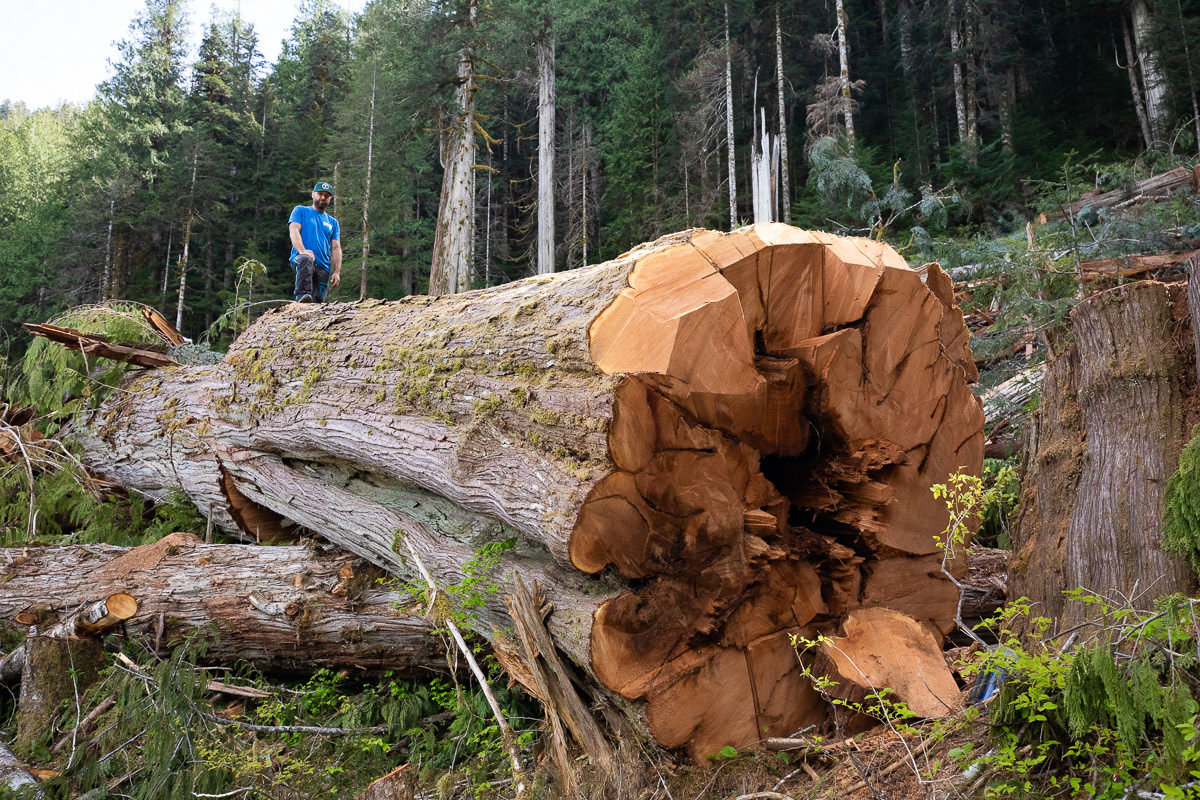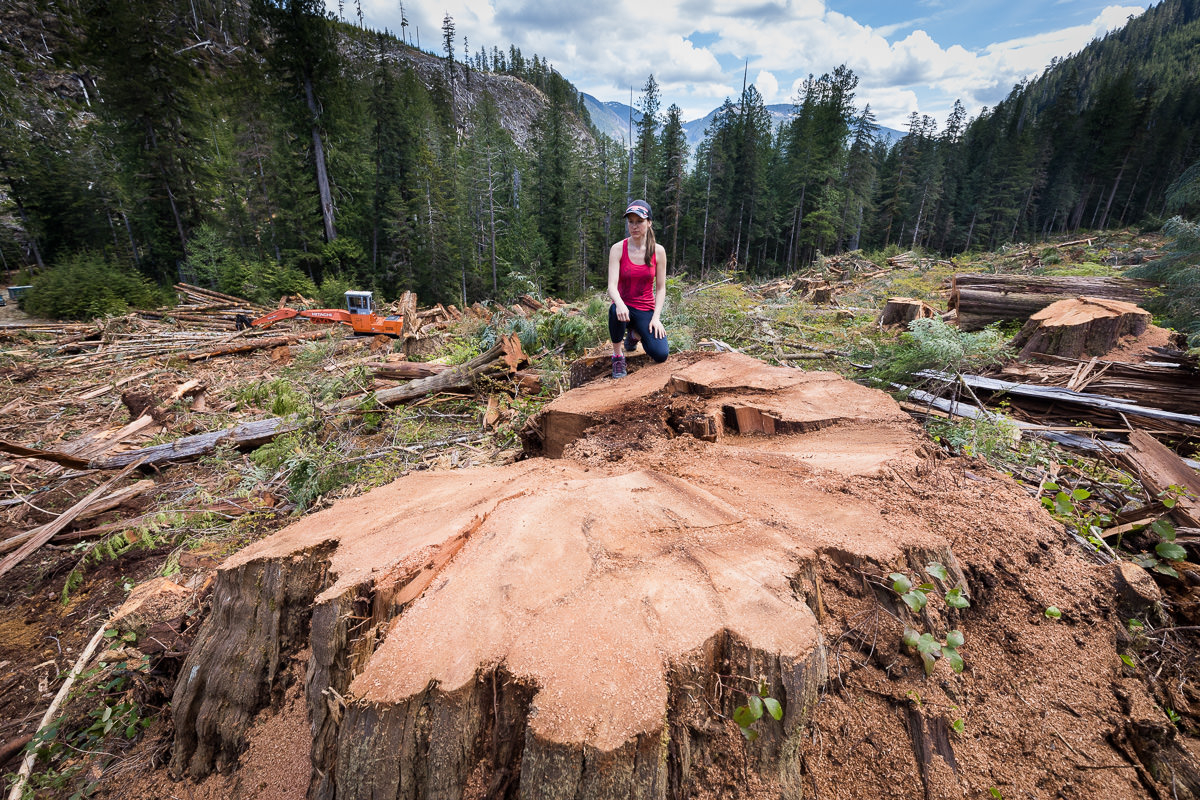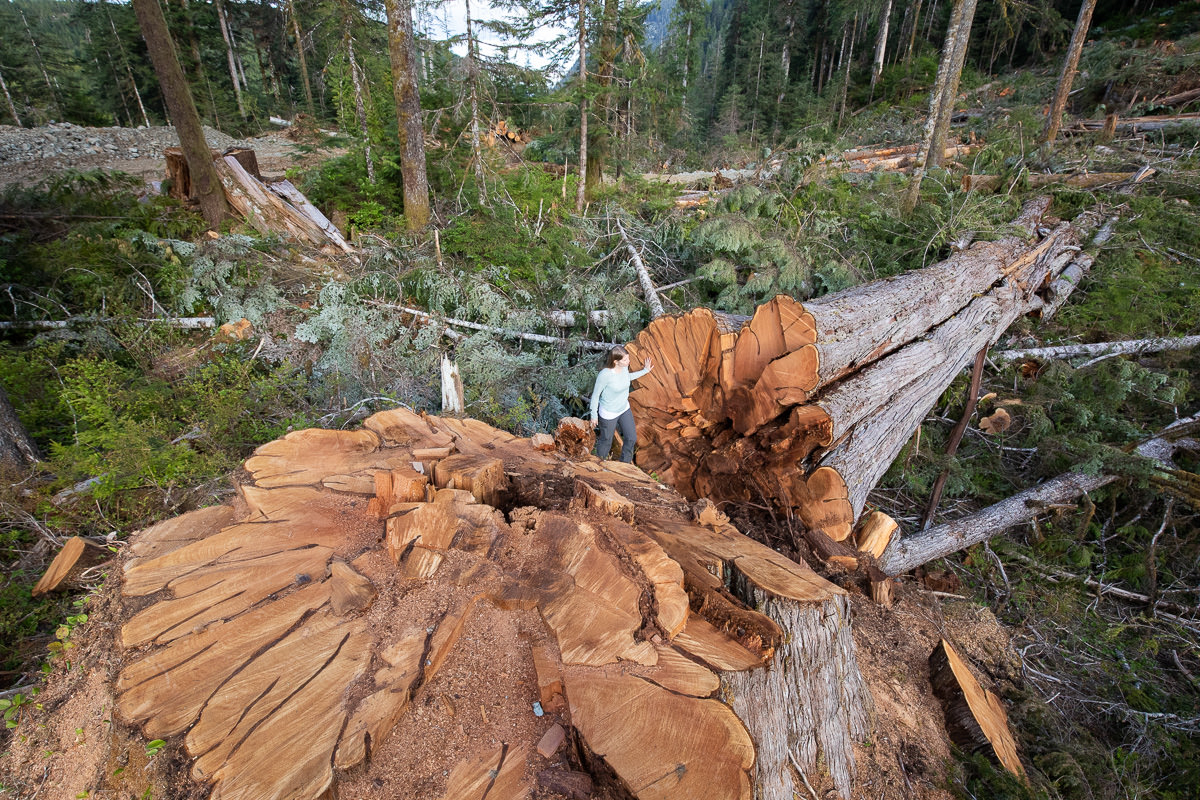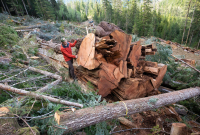Support strong Canadian climate journalism for 2025
Andrea Inness, a forest campaigner with Ancient Forest Alliance, and several other people went on an expedition on May 6, to the Nahmint Valley, which is about an hour outside of Port Alberni on logging roads. Once there, they were horrified to find massive, centuries-old red cedar and Douglas fir trees being cut down.
“We expected to see some logging, but we were all astonished to see how much had taken place. There were near record-breaking trees that we found that were being cut,” Inness said in an interview. “We were shocked at the scale of the logging and so dismayed to see these cedars lying on the ground.”
Adam Olsen, the B.C. Green Party critic for forests, said this issue could become a big problem for the government, if they don't change their policy. More on that further down.
Inness says the group found a tree equivalent to the fifth widest Douglas Fir tree in the country and another that was equivalent to the ninth widest.
“We were just back there (on May 23) and it had been logged,” Inness said. “It was heartbreaking. It’s an absolute failure on the B.C. government’s part to protect these rare and endangered trees.”
Although size isn’t necessarily indicative of the exact age of a tree, Inness said those big trees are between 500 and 1,000 years old. And irreplaceable.
“It’s almost as if the government itself was condoning the slaughtering of white rhinos or the harpooning of blue whales. It’s unbelievable,” Inness said.
The government freely admits that logging is still going on in old-growth forests on Crown land in B.C., but says it is continuously reviewing practices to ensure that logging is sustainable and ecosystems are healthy.
In its election platform, the NDP promised to work with First Nations and communities to “modernize land-use planning to effectively and sustainably manage BC’s ecosystems, rivers, lakes, watersheds, forests and old growth, while accounting for cumulative effects. We will take an evidence-based scientific approach and use the ecosystem-based management of the Great Bear Rainforest as a model.”
The 6.4-million-hectare Great Bear Rainforest was created by a 2016 agreement between the B.C. government and Coastal First Nations to conserve 85 per cent of the forest and 70 per cent of the old growth.
Protecting old growth forests is a vital component of modernizing the land-use planning process, said Doug Donaldson, B.C.’s Forests, Lands, Natural Resource Operations and Rural Development Minister.
“As part of Budget 2018, we committed $16 million over three years to modernizing the land use planning process and work has already begun,” Donaldson said in a statement. “The first step is collaborating with Indigenous Peoples. More information about land use planning will be coming this fall.”
Donaldson said more than 55 per cent of Crown old growth forests on B.C.’s coast is protected and that on Vancouver Island more than 40 per cent of Crown forests are considered old growth, including 520,000 hectares that will never be logged, but that the land-use plan on the island allows for logging in certain areas and logging supports jobs in rural communities.
But still, felling these giant trees is completely legal, even on Crown land, with permits issued by BC Timber Sales, a government agency that provides the cost and price benchmarks for timber harvested from public land in British Columbia.

People are furious about the loss of these trees, MLA says
"People are furious about what's been going on," Olsen, the B.C. Green Party critic for forests, told National Observer. "People have not responded to any other campaign more abrasively and angrily than they are this one. We've received over 4,000 emails on this issue all within a few days."
Olsen said the Greens would like to see the government stop auctioning off the right to log these trees and to work on developing a sustainable second-growth logging industry. He doesn't believe the government is getting the highest value possible for these trees and that it needs to look beyond the immediate short-term economic gains of cutting them down.
"With so much of the old growth already cut, ... certainly it would be our desire to see the B.C. government taking a different approach," Olsen said. "It is essentially extending the same unsustainable practices that the former government took to devastating habitat."
The Ancient Forest Alliance and other B.C. environmental groups are also calling for an end to logging ancient trees.
“We are calling on the B.C. government to implement a comprehensive, science-based law to protect endangered old growth forests,” Inness said. “We want not only a policy that protects the largest trees on the coast, of which these would absolutely qualify, with buffer zones around them, but also, beyond just protecting big trees, we need to protect entire forest ecosystems.”
The environmental groups aren’t alone. The BC Chamber of Commerce said in 2016 that “many local communities economically would stand to receive a greater net benefit in revenues and jobs over the ensuing decades from the protection of key old-growth forests in their region.”
Also in 2016, the Union of British Columbia Municipalities (UBCM) passed a motion calling for the protection of old-growth forest on Vancouver Island because of its “significant economic, social and environmental value as wildlife habitat, tourism resource, carbon sink and much more.”
Even the Public and Private Workers of Canada (PPWC) has called for the protection of old-growth rainforest on Vancouver Island, for forestry companies to transition to second-growth logging and for an end to raw-log exports.

Ancient trees play a vital role in climate change, survival of species
These ancient trees play a vital role in climate change – they can store two to three times more carbon than second-growth forests, Inness said. They are also very important for endangered and threatened species.
The Nahmint Valley is home to Roosevelt elk, black-tailed deer, cougars, wolves, and black bears, as well as species that live only in old-growth forests, like the marbled murrelet and northern goshawk. Olsen also emphasized that old-growth forests provide productive spawning areas for salmon.
The AFA would like to see B.C. protect all old-growth forests and make the transition to a second-growth forest industry now, rather than when all of the non-protected old-growth forests are gone.
“We need incentives for companies to retool their mills and we also need more incentive to add value to the wood here in B.C. and at the same time, curbing raw log exports,” Inness said. “That would not only sustain the amount of forestry jobs in B.C., but possibly even increase forestry employment in the province.”
A future in which BC's rare and beautiful old-growth forests remain intact, but with jobs to spare in its economy is a future worth fighting for. This future must include a flourishing second-growth forestry industry and a sustainable transition for First Nations. The B.C. government promises progress by the fall. Let’s hope that includes a move to make it a crime to cut down these majestic, centuries-old trees.
Tracy Sherlock writes about B.C. politics for National Observer. Send news tips and story ideas to [email protected]. And don't miss her next column: Use the promo code SHERLOCK today and save 20% on an annual subscription.






Comments
The headline says "You won't believe who's doing it."
Who is doing it? Do you have a name for the logging company cutting these trees?
It's the BC government giving out the permits to local independent logging companies through their agency BC Timber Sales.
Yes, we get that Chris. This is still legal, as you say in the article. This means there is a law and there are bureaucrats doing their job, that's all. So the question is still the same - who is cutting the trees down? The next article might focus on the law that needs to be changed.
Ok Graham. Good feedback and here you go: https://www.nationalobserver.com/2018/06/12/opinion/environmentalists-a…
I can't believe who's doing it! Because I still don't know after reading and rereading the article! Why won't you tell us?!!
Graduates of the School of Trolling Journalism. Kind of takes away from the point of the article, sadly.
The headline was originally "...And you won't believe who's doing it!" This was a misleading headline as the article does not tell us "who's doing it", which I feel takes away from the article. I have come to expect better of the National Observer than clickbait. I tried to point this out in a humorous way. I'm glad to see that the headline has been revised to better reflect the content of the article. Not a troll: I've been a subscriber since shortly after the National Observer was launched a few years ago. I have been consistently impressed with the quality of research and writing in the National Observer. The National Observer is an excellent publication full of top-notch journalism, this piece included.
Here you go Daryl. We've done another article fleshing things out: https://www.nationalobserver.com/2018/06/12/opinion/environmentalists-a…
Rape and Plunder. Earth first will Log the Other Planets Later